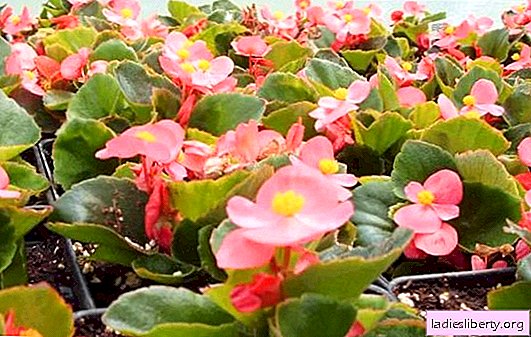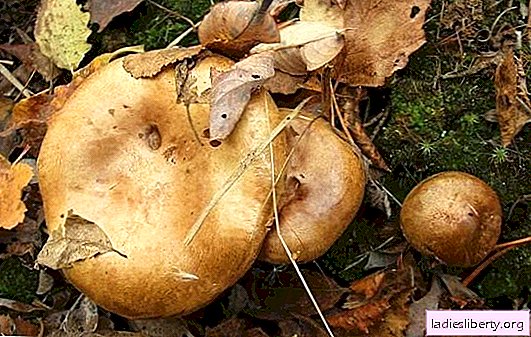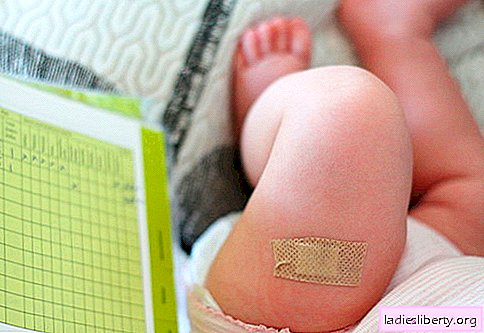
Growing begonias from seeds is not an easy task; certain knowledge and skills will be required.
In this way, you can grow tuberous, ever flowering and decorative-leafy varieties of begonias. To avoid mistakes, read the detailed instructions.

When and how to grow begonia from seeds (photo)
For the normal development of begonias, warmth and light are needed, therefore sowing is done not earlier than the beginning of March. At this point, daylight hours will increase, therefore, illumination for plants is not required.
For further cultivation, favorite varieties are chosen. Seeds are bought at the store. They are of two types:
• ordinary, without shell, very small;
• granular coated tablets in a shell.
For beginners, it is preferable to stop on granular seeds, it is more convenient to lay them on the surface of the soil, observing the required distance. Regular seeds are sown in a container, after which the sprouts are thinned out.

To get a flowering bush, you first need to grow begonia seedlings. Granular seeds are conveniently planted in coconut or peat moss tablets. This allows you to do without picking, since the root system is very fragile and is afraid of unnecessary manipulations.
Instructions for planting seeds in tablets:
1. Place the tablets in a pan with water, leave until completely wet.
2. Spread the seeds in each tablet, sprinkle lightly with water so that the pellet is pulled into the soil. You do not need to dig a seed!
3. Cover the tablet with a plastic cup or jar, water and monitor the humidity level in the greenhouse.
This method has one minus. By themselves, the seeds germinate for a long time, and granular seeds even longer. You have to wait until the shell dissolves, which increases the germination time.
Tip! Always use 2 times more seeds than necessary. After all, some may not rise at all.

Ordinary seeds are sown in a container for seedlings. It is filled with light soil. Soil is well watered a day before planting. Sowing small seeds is very difficult, but there are secrets.
• seeds are mixed with sand and evenly distributed on the surface of the soil;
• seeds are laid out on white paper and spread in a container with patting movements;
• Seeds are distributed with the tip of a wet toothpick.
The containers are covered with glass and cleaned in a bright, warm place. Shoots appear on 10-25 days, all this time the temperature is maintained at + 25 ° C.
How to care for seedlings of begonia grown from seeds
When the seeds hatch, they continue to maintain a high level of humidity in the greenhouse. No need to remove film or glass immediately. This will only harm young shoots.

Seedlings need careful care. They are watered only in a pan, excess water is drained after 1 hour. If you use the top watering, it is better to do it pointwise. To do this, use a syringe or syringe. Try not to fill the begonia, otherwise the insidious "black leg" will appear, the seedlings will die.
For seedlings, keep the temperature at +21 ° C. Watch out for lighting. If there are cloudy days or there is not enough natural light, then it is better to use artificial lighting. Begonia daylight hours should be 12 hours.
If these simple rules are not followed, then the seedlings are affected by fungal diseases, grow slowly, and may die.
How to dive begonia seedlings
If seedlings of begonia from seeds were grown in tablets, then it is not necessary to dive. It is enough to tear the bottom edge of the tablet and plant the seedling in a large container.
A pick is done for seedlings grown in containers. Over time, it becomes crowded, the area of nutrition decreases. Sprouts dive when three real leaves appear on them, they look healthy and strong.

Dive Instructions:
1. Take larger glasses, make holes in them, pour a good layer of drainage.
2. Fill the containers with the soil used to germinate the seeds.
3. Carefully transfer the sprouts with a lump of earth into a new container, water.
If plates are used instead of glasses, then 5 plants are dived into one container. Spiked seedlings are exposed to a bright place, but the temperature is reduced so that the shoots do not stretch. Two weeks later, young begonias are fed.
After 25 days, the seedlings will grow up and can be transplanted into a permanent pot. The plant blooms in early summer, the duration of flowering depends on the variety and growing conditions. On the street, the plant blooms to frost.
Features of cultivation and care of begonias from seeds after a pick
Begonia is used to decorate a room, terrace or balcony. Some varieties can be planted in the open ground for the summer. Indoor plants need special care.
Primary requirements:
• begonias need a lot of space, it does not tolerate neighborhood with other plants;
• the flower develops well only with high humidity;
• use only settled water for irrigation;
• feed begonia with complex mineral fertilizers for flowers;
• replant the plant once a year.
If you fully comply with these requirements, the plant will develop well, and flowering forms - fully bloom.
Begonia is demanding on lighting, so it is better to put a flower pot in a bright place, but protect it from direct sunlight. Consider that variegated forms need lighting more than blooming. The latter can tolerate light partial shade. In winter, all begonias need additional lighting, otherwise their shoots are extended.
Begonia is watered abundantly, but water should come out of the drainage holes. An hour after watering, excess water is poured from the pan. In summer, it is useful to spray the leaves to raise the humidity around the plant.
Begonias do not have a clear dormant period, but the plant needs to rest, especially in ever-flowering forms. In the fall, watering is reduced, and in winter it is minimized. The pot is cleaned in a cool room. In this state, begonia hibernates. In spring, the plant is returned to its original place. Elongated shoots need to be cut.
Problems When Growing Begonia From Seeds
Mistakes happen to everyone. How to help a plant if it gets sick, drops leaves and buds?
The main mistakes and ways to solve them:
• The leaves began to fall off, the tips are brown - the air around the plant is too dry. Spray begonia with warm water more often.
• Leaves turn yellow and fall - the plant does not have enough light. Move the pot closer to the window or use additional illumination.
• Leaves and stems are watery - the fungus has settled, the plant begins to drive, it is flooded. Cut and root healthy parts. Transplant the diseased plant into new soil, treat with fungicides.
• White plaque on the leaves - powdery mildew, appears from temperature changes. Begonia is treated with colloidal sulfur.
Most often, begonia, which is grown on the street, suffers from pests and diseases. Before you bring the plant into the house, do preventive treatments with complex preparations. Keep the pot separate in the room until the quarantine period has passed.











